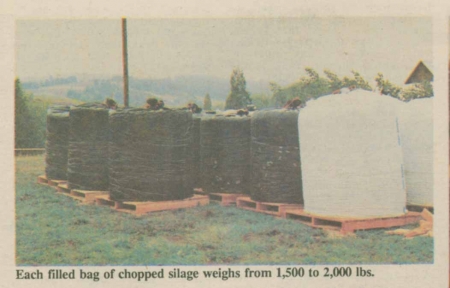
"Works great for farmers who don't have a big herd to feed. There's no spoilage and cattle love it," says John Vardanega, Warren, Ore., who stores chopped silage -- made from corn, alfalfa, oats or even barley -- in round bale bags.
"We built a round form with hinges and locks that's just the size of a bag and 60 in. high, which we set on a wooden pallet. We inflate the bag with air using a small squirrel cage fan connected to a short piece of pipe before we put it into the form. Blowing the bag up first prevents any wrinkles from forming. The excess is folded down over the sides of the form.
"We chop into a truck with a moveable endgate, introducing a preservative at the chopper. The truck empties into a short conveyor which dumps into the bag. One person feeds the conveyor and one distributes the chop as it enters the bag and packs it down by walking around on it. When the bag is heaped full, the top of the bag is gathered up around a short piece of 1-in. plastic pipe and tied with plastic twine. Then we connect a shop vacuum to the pipe and suck out all the air we can, which collapses the bag and tightly compresses the silage. The final step is to seal the bag by tightening up the first twine string with a small hand tool we built for the purpose, folding over the excess plastic, and tying it again.
"Using a pallet fork we built for our tractor 3-pt., we move the pallet and bag into storage and remove the form. It takes 2 to 3 weeks for the silage to 'cure'. Each filled bag weighs between 1,500 and 2,000 lbs.
"This method produces an excellent feed and is a great way to make use of crops that might otherwise go to waste because of poor weather conditions."
